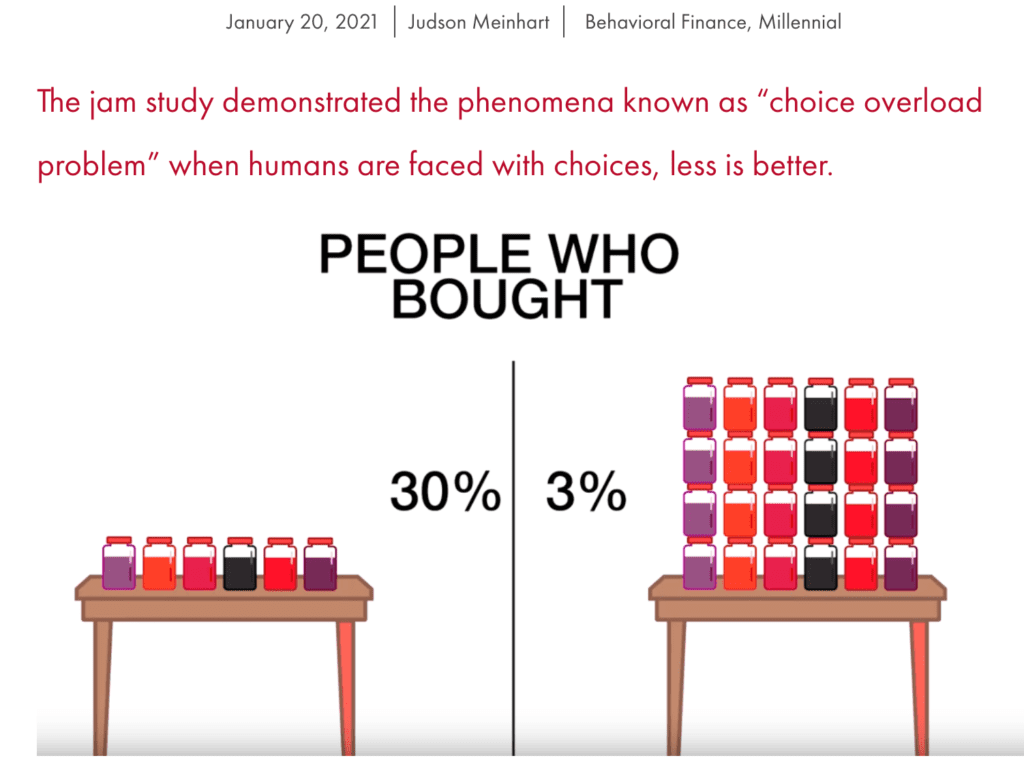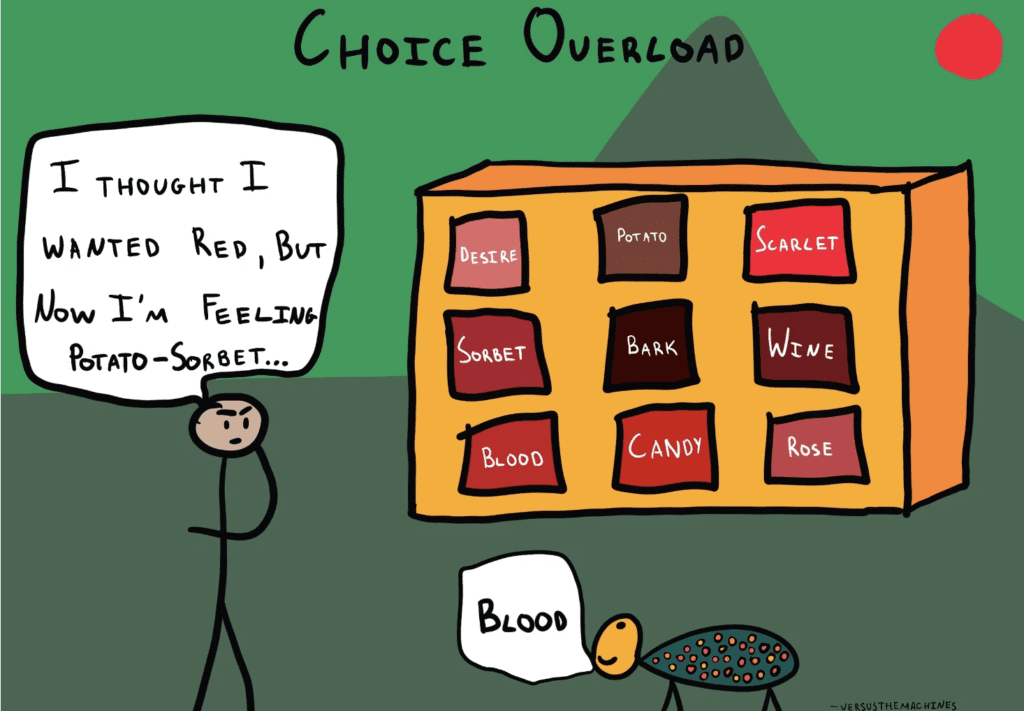In our role as advisors, we see all kinds of human behaviours in our clients along their varied journeys. Some behaviours are enablers, some are just part of the process, and others are disablers.
One critical disabler relates to the inability to make a decision, and this disabler can grip for many reasons, including third party influence, fear, and distraction, but one reason we don’t often acknowledge relates to choice paradox, and more specifically, overchoice.
Too many options can lead to a total inability to choose.
We often use the phrase, “like a kid in a candy store”, which suggests the child is revelling in the amount of candy on offer and enjoying themselves far too much, yet this doesn’t actually ring true for consumers.

Many studies in the field of pyschology have been conducted and the findings for various behavioural-economics related studies are fascinating.

“Alvin Toffler, (a prominent futurist) noted that as the choice turns to overchoice, “freedom of more choices” becomes the opposite—the “unfreedom”. Often, a customer makes a decision without sufficiently researching his choices, which may often require days. When confronted with too many choices especially under a time constraint, many people prefer to make no choice at all, even if making a choice would lead to a better outcome.” (Source: Wikipedia)
“According to George Miller in 1956, (behavioural scientist and academic), a consumer can only process seven items at a time. After that the consumer would have to create a coping strategy to make an informed decision. This can lead to consumers being indecisive, unhappy, and even refrain from making the choice (purchase) at all.” (Source: Wikipedia)
Another psychology expert, Sheena Iyengar conducted a study known as the “jam study”, and the experiment and results are simple, yet so compelling.
“In this particular experiment, two sets of consumers were offered a selection of jams. One set was offered six flavours, the other set was offered 24. The set of consumers who were offered the 6 flavours were 10 times more likely to purchase a jar than consumers who faced a choice of 24 flavours.” (Source: ParsecFinancial)

So how does this relate to property purchasing?
Choice relates to all kinds of commercial selections, and the cost-magnitude associated with real estate decisions carries enormous weight. In fact, it’s one of the heftiest commercial decisions that most people will make in their lifetime, so the anxious feelings that some may experience with choice will likely be amplified.
For some, the anxiety can be paralysing, and pending the influencer’s around them, (loved ones, partners, family, friends, news-feeds), their inability to cope wth decision making can make the difference between purchasing well, remaining on the sidelines indefinitely, or purchasing something left-field (or disastrous). However, we do need to understand how humans make decisions, and in particular, the difference between variety and complexity, because different people will face challenges for either, neither or both.
“Variety is the positive aspect of assortment. When selecting an assortment during the perception stage, the first stage of deciding, consumers want more variety.” (Source: Wikipedia)
“Complexity is the negative aspect of assortment. Complexity is important for the second step in making a choice—when a consumer needs to choose an option from an assortment. When making a choice for an individual item within an assortment, too much variety increases complexity. This can cause a consumer to delay or opt out of making a decision.” (Source: Wikipedia)

We also have to be able to recognise how a specific client faces decision making, how they prefer to tackle the process, and what sort of help they will need. While we can’t simply categorise personalities into two easy boxes, there are two broad decision-making types that have been identified by behavioural scientists, and both of these types carry their own challenges.
A satisficer relates to someone who is merely looking for an option that meets their basic requirements. They can be happy with a 7/10 option and don’t feel compelled to find the 10/10. The word stems from the combination of satisfied and suffice.
Satisficers aren’t always easy to work with, because our job is to ensure that they get a much better outcome than that of a 7/10. Whether it’s boredom, disinterest, sheer pragmatism or an overall sense of ‘glass half full’, this approach isn’t optimal for us as buyer’s agents. When it comes to clients who are pure satisficers, we will try to optimise their result by rejecting properties and providing compelling, critical feedback.
A maximiser relates to someone who is ardently trying to find the very best available option to them. Traits can include a desire to consider every single choice, careful evaluation of each on many different measures, and sometimes, seeking an obvious sign that their final choice is the stand-out choice.
Maximisers are particularly difficult in fast-paced, high-stakes environments such as property. Aside from the fact that they can often be looking for something scoring 100%, (and properties are like people; none are perfect, but many are exceptionally good), maximisers often take so long weighing up every pro, con and consideration, that they miss the boat entirely. A severe dose of maximising can lead to analysis-paralysis and ongoing regret as they watch high-scoring properties sell for prices they could have afforded, and later realise that their calibration for selection and scoring was excessively high.
We’ve used the phrase “FOBBABO” plenty of times before, and sometimes it’s a warranted and helpful approach, but sometimes it stems from maximising.
FOBBABO stands for fear of buying before a better option.
Waiting for that better, more perfected option can be a costly approach, particularly when a market is rising or suddenly rises.
“Although it’s true that choice overload is a strong and pervasive bias, there are steps that can be taken to reduce its power over us. With discipline and some advance planning, the decision-making process can be tweaked a little bit, to help avoid becoming overwhelmed.” (Source: The Decision Lab)
Having a clear plan, a list of must-haves and nice-to-haves, a defined search locale and an array of recent sales supporting your preferences and budget is the best approach to avoid choice-overload when shopping for a property.
REGISTER TO OUR NEWSLETTER
INFORMATION
CONTACT US
1A/58 ANDERSON STREET,
YARRAVILLE VIC 3013
0422 638 362
03 7000 6026
CATE@CATEBAKOS.COM.AU
